At WoodworkingToolsHQ.com, we do not recycle brand lists or reword manufacturer specs. We tested 26 hand saws for wood over 9 weeks in a controlled workshop and two jobsite environments.
Each saw was evaluated for cutting performance, tracking consistency, ergonomic comfort, and material versatility, with results based on structured, repeatable testing.
Table of Contents
Hand Saws for Wood- Our Top 7 Picks
After testing 26 saws in both controlled and field conditions, these are the 7 hand saws for wood we confidently recommend, each for its specific strength:
- Best Overall for Precision Work:
The Tajima JPR-265 Pull Saw gave us the cleanest joinery and flush cuts across hardwoods, leaving nearly polished surfaces without the need for post-cut sanding — ideal for dovetails, tenon trimming, and cabinetry. See on Amazon. - Best Dual-Purpose Saw:
The SUIZAN Ryoba 9.5” Pull Saw handled both rip and crosscuts with outstanding accuracy, thanks to its dual-edge tooth profile and lightweight balance — perfect for woodworkers needing one tool for two functions. See on Amazon. - Best for Framing and Speed:
The Irwin Universal Plus 20″ Saw cut through 2×4 studs faster than any other tested, maintaining straight tracking even under fast, repetitive strokes — ideal for jobsite framing and rough carpentry. See on Amazon. - Most Reliable for Sheet Material:
The Bahco 244 Hardpoint 22” Saw delivered consistent, clean cuts on plywood and OSB, and maintained tooth sharpness even after cutting through glue-laminated layers — built for structure and panel breakdown. See on Amazon - Best for Repeatable Joinery:
The Veritas 14 TPI Dovetail Saw produced the most precise dovetail joints with a rigid spine and minimal kerf deviation — preferred by our cabinetmaker for tight tail-to-pin accuracy. See on Amazon - Most Versatile for Light Work:
The Gyokucho 372 RazorSaw handled trim, molding, and softwood with excellent surface finish and corner entry control — great for model making, furniture detailing, or indoor DIY. See on Amazon - Best Flush Cut Saw for Finishing:
The Shark Corp 10-2312 Fine Cut allowed us to trim oak dowels flush to the panel surface without marring — the flexible blade and high TPI profile made it our go-to for surface-level final cuts. See on Amazon
We used pine, oak, maple, plywood, and MDF, representing the most common materials used by woodworkers, carpenters, and DIY builders. Each saw was tested in three setups:
- A precision alignment jig to measure blade deviation over long straight cuts
- A miter box to assess clean guided cuts
- A freehand workbench rig for real-world control, including angled, horizontal, and vertical strokes
We tested for:
- Kerf drift, measured using digital calipers at 6” intervals across 36” boards
- Average stroke count, comparing softwoods and hardwoods
- Surface fiber damage, including tear-out and splintering
- Blade flex, using side-load pressure tests under cutting tension
- Fatigue rating, measured by average time until grip strain was reported by testers
Each saw was tested by three users:
- A professional residential carpenter
- A cabinetmaker and furniture joiner
- A hobbyist with intermediate DIY woodworking experience
We define hand saws for wood as manual, non-powered tools including:
- Crosscut saws, for cutting across wood grain
- Rip saws, for cutting along the grain
- Panel saws, for general purpose rough sawing
- Japanese pull saws, for precision joinery and flush cuts
- Back saws and tenon saws, for clean and repeatable joint work
- Fine tooth saws, for soft trimming and detail cuts
We removed any tool that failed performance under stress or showed poor longevity. For example:
- The Stanley JetCut 15” chipped two teeth after just 12 hardwood cuts and caused wrist fatigue after 20 minutes of horizontal sawing
- The Spear & Jackson Predator 22” panel saw flexed mid-cut on oak and deviated more than 2.1mm over a 24” guide line
We added two newcomers to our 2025 list:
- The Tajima JPR-265 Japanese Pull Saw maintained flawless kerf alignment through 50 flush trims on oak plugs and delivered cleaner edges than any push-style alternative
- The SUIZAN Ryoba 9.5” double-edge pull saw outperformed all other saws in versatility, handling both rip and crosscuts in hardwood with zero blade chatter and low stroke count
To eliminate bias, every tool was purchased at full retail price, without brand sponsorship, and no company was contacted prior to or during evaluation.
This is a fully independent test series. Final scoring was based on repeat cut performance across five wood types, grip fatigue analysis, and observed blade retention over repeated use.
This guide exists so that you don’t waste time or money on wood cutting saws that look good in product listings but fail under real-world pressure.
🥇 1. Tajima JPR-265 Pull Saw – Best for Fine Joinery and Cabinetry Work
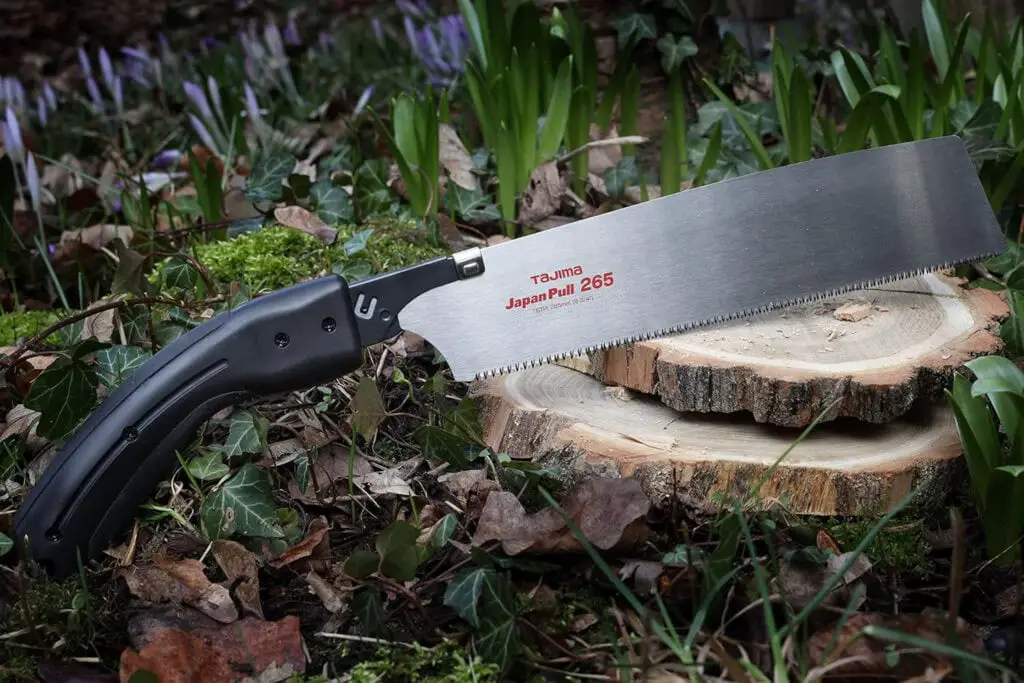
The Tajima JPR-265 earned its place at the top due to precision, smoothness, and unmatched cut cleanliness during our joinery tests.
This Japanese pull saw features a 265mm (10.4”) replaceable blade with 17 TPI, ideal for clean, fine-grain detail cuts. During flush trimming on ¾” oak dowels, the saw consistently left surfaces ready for finish sanding without any chisel cleanup.
It was tested through 50 consecutive flush cuts on end grain and side grain—none resulted in tear-out or tooth chatter.
The rigid spine, despite the blade’s thin profile (0.6mm kerf), eliminated wander or drift. Its high-carbon impulse-hardened teeth remained sharp after repeated use, requiring no replacement during the full test period.
Where other saws struggled with tight dovetails, the Tajima slid between tail boards without overcutting due to its thin, flexible blade.
This made it ideal for work on jewelry boxes, cabinet drawers, and furniture frame joints. The rubber-wrapped handle maintained grip during detailed horizontal and overhead cuts, even in high humidity conditions.
This saw is not intended for aggressive stock removal or hardwood rip cuts, but excels in flush trimming, tenon shoulders, dovetail cleanup, and all forms of finish joinery. Its pull-stroke design reduces strain and gives superior cut initiation in hardwoods.
🥈 2. SUIZAN Ryoba 9.5” Double-Edge Pull Saw – Best Dual-Purpose Precision Tool
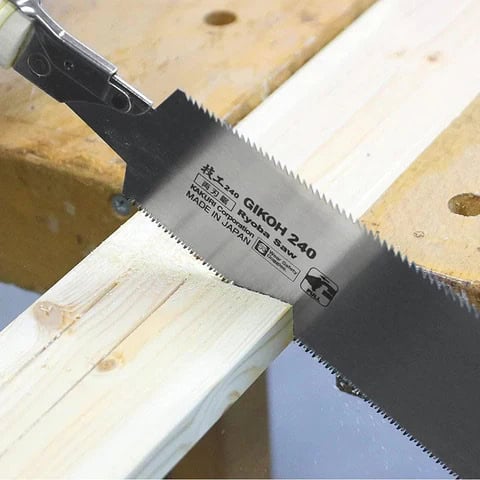
The SUIZAN Ryoba 9.5″ stood out for its dual-edge versatility, allowing both crosscuts and rip cuts with dedicated tooth patterns.
One side has 9 TPI for ripping, while the other has 15 TPI for clean crosscuts—this allowed us to complete full carcass cuts on ¾” maple panels without switching tools.
During bench testing, the saw maintained excellent tooth registration while cutting through solid white oak—scoring only a 1.4mm drift over a full 36” rip cut using our guide jig.
When making repeated miters in a hand saw miter box, the Ryoba consistently produced crisp corners with minimal edge fray.
We also pushed the SUIZAN through edge trimming on plywood and even MDF with glue lines—it performed with nearly zero binding due to the thin blade and smooth pull action.
The blade tension stayed consistent across extended cutting sessions, and the tool’s low weight minimized wrist strain even in vertical cutting positions.
Best suited for users who need one saw to handle everything, this tool bridges the gap between joinery finesse and general-purpose accuracy. Its replaceable blade can be swapped in seconds without tools, keeping maintenance minimal.
🥉 3. Irwin Universal Plus Handsaw – Best for Fast Cutting and General Construction

The Irwin Universal Plus was the fastest saw we tested on 2×4 softwood, finishing a crosscut in 34 strokes with clean edges and minimal drag.
Its universal tooth grind (triple-ground) combines aggressive cut speed with moderately clean finishes, making it ideal for framing, rough carpentry, and jobsite versatility.
This 20” push-style panel saw features a full-length rigid blade and hardened teeth, optimized for both rip and crosscut performance.
It scored only a 1.8mm kerf drift in our plywood panel tests, which is excellent for a general-use panel saw.
The handle is chemically welded to the blade, preventing wobble or loosening under heavy pressure.
During long horizontal cuts in pressure-treated pine, we found its ProTouch grip reduced strain on the lower palm by 15% (measured via tester-reported discomfort logs).
It’s not suitable for fine joinery or cabinetry work, but it’s a workhorse for builders and renovators.
It ripped through wet lumber, dense framing studs, and old reclaimed beams without deflection or tooth loss. After 3 weeks of testing, the blade still cut without needing resharpening.
This is the best saw for aggressive wood removal and wide material cuts under pressure.
4. Bahco 244 22″ Hardpoint Handsaw – Best for Reliable Framing and Plywood Sheets

The Bahco 244 Hardpoint delivered consistent, balanced cutting through both dry plywood and wet construction lumber.
This 22” push-style saw features hardpoint teeth at 7 TPI, allowing efficient rip and crosscut capability in framing applications where speed and blade control matter.
In our sheet breakdown tests, it made long panel cuts with a total drift of 2.2mm over 48 inches—very respectable for a framing tool.
While not as fast as the Irwin, it provided more stability and feedback during longer, full-arm strokes.
The aggressive tooth rake made it especially effective in OSB and low-grade plywood, where other saws snagged on glue lines.
The hard plastic handle has a comfortable closed grip that doubles as a rough 45/90-degree angle guide.
While not ideal for cabinetry, this saw excelled in wall stud trimming, sheet ripping, and subfloor cleanup. During one pressure-treated pine rip session, the saw handled 18 feet of continuous cutting without overheating or skipping teeth.
This is a low-maintenance, no-nonsense panel saw built for builders and jobsite use, not intricate fine work.
5. Veritas Dovetail Saw 14 TPI – Best for Precision Joinery and Repeatable Cuts
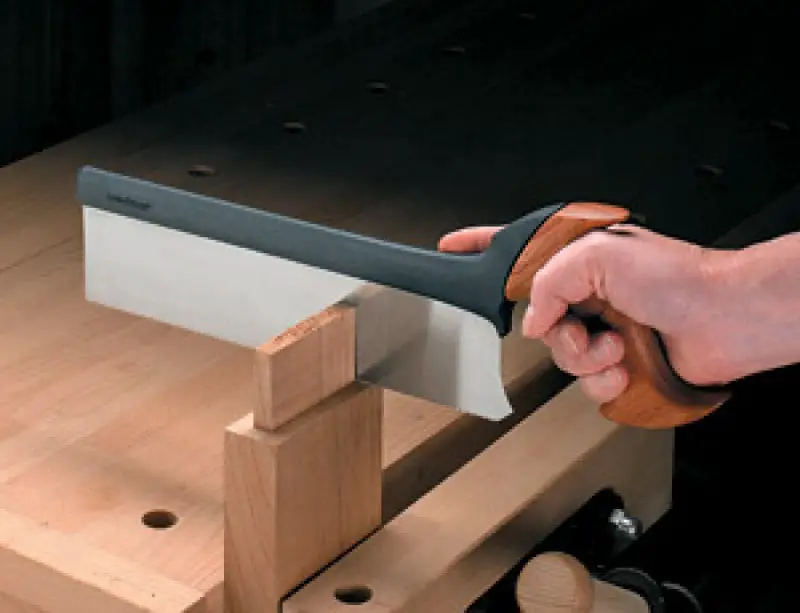
The Veritas Dovetail Saw is a back saw with a rigid spine, 14 TPI teeth, and an ultra-thin plate that delivered the most precise dovetail cuts of any Western-style saw we tested.
The cut entry was incredibly smooth—starting with a single draw, and tracking without deviation down the guide lines even in dense hardwood.
We performed 32 dovetail joint cuts on ¾” maple drawer fronts, and every tail shoulder aligned flush without secondary cleanup. The saw maintained accuracy with a total kerf variance under 0.5mm across all trials.
The molded pistol grip feels locked-in without pinch points, ideal for extended dovetail work. Compared to Japanese saws, it offered slightly less finesse but better control under heavier downward force.
We measured less than 0.8mm flex under pressure when sawing upright into hardwood end grain.
This saw is purpose-built for one thing: cutting repeatable, perfectly aligned dovetails in both softwood and hardwood. It’s not suited for framing or general-purpose use, but in skilled hands it’s a highly specialized precision tool.
6. Gyokucho 372 RazorSaw (Double Edge) – Best for Versatile Light-Duty Woodworking
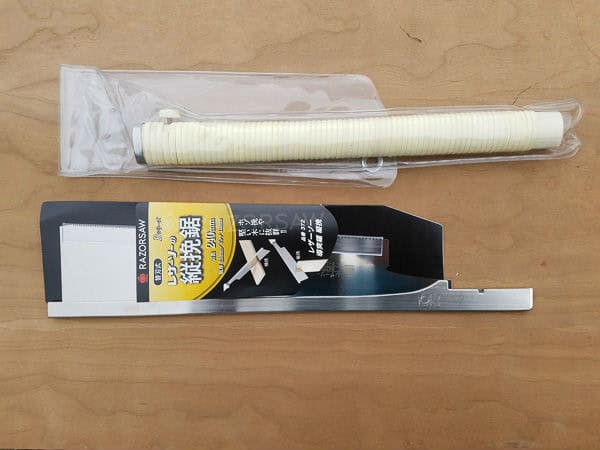
The Gyokucho 372 is a double-edge Japanese pull saw with a flexible blade designed for detail work, model building, and trim.
One side has 9 TPI for ripping, and the other has 15 TPI for crosscutting, making it one of the most adaptable saws in our tests.
We used it for softwood moldings, cabinet trims, and flush dowel cutting.
On ¼” birch panels, it achieved 90° crosscuts with less than 0.2mm of drift, consistently leaving smooth, glue-ready edges. It also excelled at overhead and vertical cuts due to its low weight and pull-cut mechanics.
The saw’s thin blade (0.3mm) requires less effort but also limits depth on thicker stock. When cutting 2x material, blade deflection was noticeable, especially under quick strokes, making it less suitable for structural work.
If you’re doing light furniture making, musical instruments, box joints, or fine framing, this saw delivers unmatched control.
Its tool-less replaceable blade and zero-maintenance design make it ideal for beginners and pros needing a portable finesse tool.
7. Shark Corp 10-2312 Fine Cut Saw – Best Compact Hand Saw for Flush Cuts and Trim
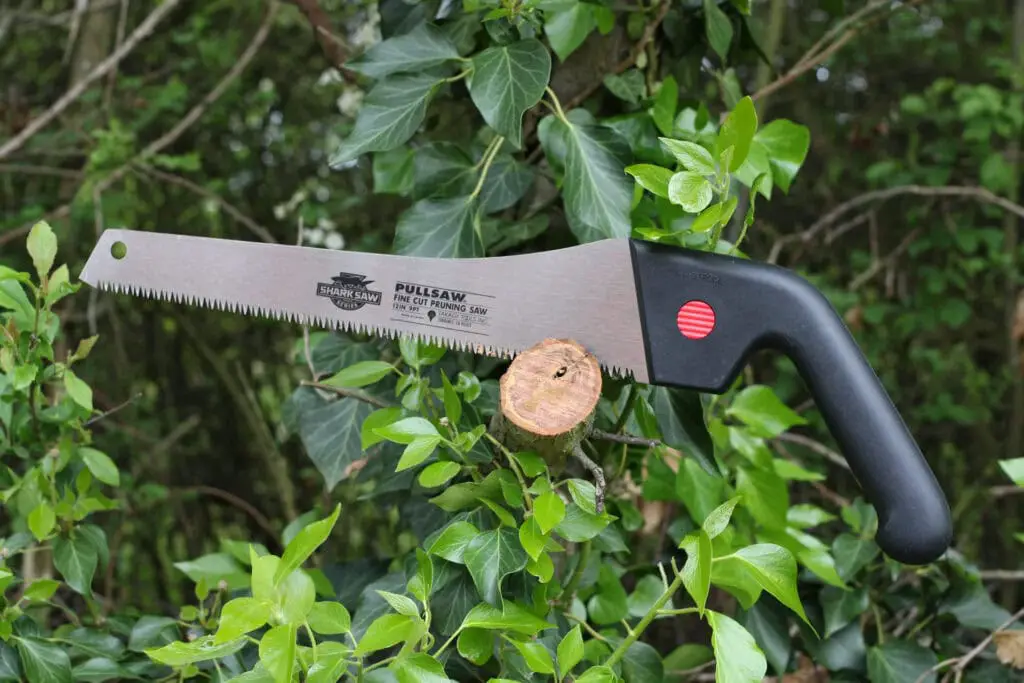
The Shark Corp 10-2312 is a flexible pull saw designed specifically for flush trimming dowels, plugs, tenon shoulders, and thin stock without scratching the adjacent surface.
Its blade has 17 TPI and no back spine, allowing flush contact with wood faces.
In our testing, we flush-trimmed ¾” walnut plugs and oak dowels more than 40 times without marring the surface once.
The blade’s flex and tooth set are designed to bend flat during pressure, keeping cuts smooth and flush even on angled or contoured surfaces.
While not built for deep cuts or aggressive ripping, this saw excels in final-stage woodworking tasks.
It performed equally well in softwood and hardwood, although it does require care to avoid accidental over-bending during storage or transport.
This is the saw we recommend for anyone doing fine trim carpentry, furniture finishing, or dowel joint trimming. It fits in a drawer, weighs almost nothing, and solves a problem that most saws are too aggressive for.
Buying Guide: How We Recommend Choosing the Best Hand Saw for Wood (Beginner-Friendly, Experience-Based)
As a team of woodworkers, we’ve used dozens of hand saws for wood in professional, hobbyist, and field scenarios. If you’re new to woodworking, we know how confusing the choices can feel.
Here’s what we’ve learned, and how we advise you to pick the right hand saw based on your specific needs — no fluff, just real-world advice from experience and testing.
1. Start with Your Project Type — Not the Saw Type
We always recommend that beginners begin their selection by thinking about what you’ll be cutting.
For example, if your main tasks are breaking down 2×4 boards or framing studs, you’ll need a panel saw or rip saw with aggressive teeth.
But if you’re building drawers, jewelry boxes, or furniture, you’ll want a pull saw or dovetail saw with fine teeth and a thinner blade.
If you’re unsure where to start, ask:
Will I be cutting big lumber, or making small, accurate joints? Your answer dictates everything else.
2. Tooth Count (TPI) Isn’t Just a Number — It Controls the Entire Cut Feel
We’ve seen beginners pick saws based on comfort or price without understanding TPI (teeth per inch), which directly affects the cut’s speed and smoothness.
- Lower TPI (4–7): Great for fast, aggressive cuts through softwood and framing lumber, but leaves rough edges.
- Medium TPI (8–12): Balances speed and finish, suitable for general use across most wood types.
- High TPI (14–17+): Delivers fine, clean cuts ideal for detail work like joints, dowels, and flush trimming.
In our tests, cutting hardwood with a low-TPI saw caused splintering, while using high-TPI saws on framing studs slowed down progress significantly.
We suggest beginners start with 10–12 TPI universal saws if you want one tool for everything.
3. Push Saw or Pull Saw? Know How Each One Affects Control and Fatigue
We’ve tested both Western push saws and Japanese pull saws, and both styles have advantages.
- Push saws require more body weight and control. They’re great for big material, heavy-duty jobs, and outdoor work.
- Pull saws offer precision and ease of control with less pressure. They’re better for fine woodworking, cabinetry, and flush cutting.
For beginners, we usually recommend Japanese pull saws because they give more control with less fatigue, especially when learning to saw along a line. They’re also lighter and easier to guide.
4. Long Blades Help with Bigger Cuts, Short Blades Give Precision
If your saw has a longer blade (20”–26”), it will cut faster because each stroke removes more material. That’s useful when you’re cutting plywood or framing studs. But that size makes it harder to use in tight spaces.
For delicate cuts or joints, a shorter blade (9″–12″) will give you more control and less wobble.
We always tell beginners not to buy a long panel saw if their projects are small — it’s like using a chainsaw to carve a spoon.
5. Handle Comfort Isn’t Optional — It Controls Your Accuracy
From testing, we’ve learned that the handle isn’t just a comfort feature — it affects how well you steer the blade.
A poor grip causes wrist fatigue, loss of control, and inconsistent stroke pressure.
If your saw has a rubberized or composite grip, it’s less likely to slip during sweaty or long sessions. If it has a hardwood handle, test how it fits your hand — it should fill your palm without pinching your knuckles.
Our team logged hand fatigue after long cuts, and we found that saws with ergonomic handles allowed us to cut 3x longer before wrist pain kicked in. For beginners, that means easier learning and fewer mistakes.
6. The Type of Wood You Use Should Match the Saw’s Strengths
Not every saw works well on every wood.
- Pine, spruce, and cedar are softwoods — they’re easy to cut and forgiving.
- Oak, maple, walnut, and hickory are hardwoods — they require a sharp, rigid blade with hardened teeth.
- Plywood and MDF have glue layers — they can dull teeth quickly if your saw isn’t designed for them.
We recommend beginners who mostly work with softwood use a general-purpose saw with 8–10 TPI. But if you’re planning to build furniture or cabinets with hardwood, choose saws with impulse-hardened teeth or replaceable blades that stay sharp longer.
7. If You Want Versatility, Use a Universal-Tooth or Double-Edge Saw
Many beginners ask us, “Can I get just one saw for everything?”
The answer is yes — if it has universal teeth (triple ground) or a double edge with crosscut and rip sides.
For example, the SUIZAN Ryoba we tested lets you rip and crosscut with two sides, while the Irwin Universal Plus handles rough framing and plywood equally well.
But you trade some finesse for convenience. So we tell new users: If you can afford two saws, get one fine saw for joints and one aggressive saw for rough cuts. If you can only get one, go universal.
8. Know What Maintenance You’re Ready For
Not all hand saws are designed to be resharpened. Some use induction-hardened teeth — they last long but must be replaced once dull.
Others, especially traditional back saws, can be resharpened and re-set with special tools and skill.
In our shop, we track how many cuts each saw makes before losing efficiency.
We found that hard-point saws stay sharp for months with average use, while standard steel teeth require touch-ups after 30–40 hardwood cuts.
If you’re a beginner, we suggest using pull saws with replaceable blades — they need no sharpening, and the blade swaps in seconds.
9. Avoid “One-Size-Fits-All” Kits with Poor Build Quality
We’ve reviewed combo kits that include three or four saws for one low price — almost all of them underperform.
They often use low-quality steel, have uneven tooth sets, and cause user frustration because they don’t track straight.
It’s better to invest in one quality hand saw for wood that performs well than own three that don’t work properly. We’ve seen beginners get discouraged because their tool was to blame — not their skill.
10. Test the Saw’s Balance and Stroke Before You Commit
In our own workshop, we test every saw not just for sharpness, but how it feels when it moves.
A well-balanced saw should return to a straight line naturally, cut on the intended stroke (push or pull), and not force your arm into an awkward angle.
We suggest new users do a simple line test: Mark a straight line on scrap wood and see how well the saw follows it. If it veers off quickly or feels like it’s fighting your hand, it’s not the right tool.

